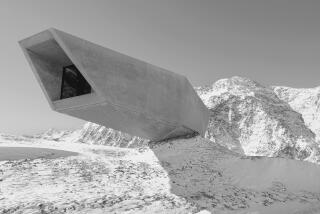Upon the Face of the Waters : WATER AND ARCHITECTURE, <i> By Charles W. Moore</i> . <i> Photographs by Jane Lidz (Abrams: $60; 224 pp.)</i> : ON WATER, <i> By Thomas Farber (Ecco Press: $20; 183 pp.)</i>
- Share via
“Water and Architecture” is a big and beguiling volume, equally suited to the coffee table or the library shelf. It traffics in an extensive range of man-made or man-manipulated materials--wood, glass, grass, thatch, plastic, gold, steel, concrete--but ultimately these are a mere flirtation. Its heart lies elsewhere. Its core story revolves around the marriage of two complementary substances: water and stone.
Likewise, the book itself is a marriage of complements--that of text and photographs, the former supplied by Charles W. Moore, a professor at the University of Texas at Austin School of Architecture, and the latter by Jane Lidz, a photographer based in San Francisco. Given two such intertwined “marriages,” a round of spousal comparisons seems all but inevitable, and I suppose you might plausibly say this: As water is to stone, text is to photograph. The words flow, they drift and slide on the current of this or that thought; the photographs are fixed and keen-edged and, however enchantingly the light plays upon them, they are solidly there .
Moore’s text displays a number of virtues. The early sections, in particular, provide some welcome background information, both of history (Roman aqueducts, early scientific attempts to understand the water-cycle and so forth) and of nomenclature (e.g. the berceaux , jets d’eau , nappes that are “principal water shapes” of chateau garden design). Moore writes a prose free of jargon, and the central argument he proposes--that water and architecture have “a part in balancing the yin and the yang,” in “restoring some semblance of balance to our teetering world”--is certainly salutary.
Better still, though, are Lidz’s photographs. She succeeds in capturing her subjects with particularity but without fuss, enhancing without exaggerating their defining qualities. And if she occasionally renders something more beautiful on the page than it is in life (I once lived for a year in Rome, during which I often visited the Trevi Fountain, but I never saw it glowing with quite the creamy, opalescent luster it has here), this is surely a “fault” that more books ought to be guilty of. To call it a fault at all (even with quotation marks around it) may be to slight Lidz’s express ambition: “to show the designer’s original intent and to evoke the splendor and spirit of each place, even though some had celebrated their finest hour centuries ago.” In the best of these photographs, you wind up saying, “That’s the way a canal in Bruges (or a Japanese moss-garden, or the Court of the Lions in the Alhambra, or--for that matter--the fountain in Rockefeller Center) was meant to look.”
Even so, just as the conjunction of water and stone involves us in the “dilemma of balancing human needs with respect for nature,” as Moore points out, so too is the issue of “balancing” fundamental to the question of how successfully “Water and Architecture” functions as a whole. And here we encounter some problems. The text and the photographs don’t work as compatibly as they might. It would have been a small matter--but a huge help--to inform us, perhaps parenthetically, where objects under discussion were to be found among the photographs; as it was, I was constantly hunting around, trying to discover whether a particular object in the text had a photographic counterpart. And where there are no such photographs, additional marginal diagrams would have diminished the reader’s gathering frustration.
It certainly doesn’t help matters that, with each new chapter, Moore dispenses less and less information and, apparently, has less and less to say himself. Simply put, there don’t seem to be enough ideas here, and his admirable avoidance of jargon degenerates into increasingly simple-minded assertions (“Throughout history lakes have been settings for cities and towns where people could live near the water”), which themselves fall prey to repetition--as when he tells us that “canals can be symbolic connectors and communicators too” and five pages later reminds us that “the canal, a man-made river, is also an important connector and communicator.”
There’s a similar lack of facts and ideas in Thomas Farber’s otherwise quite winning “On Water,” a nonfictional, mostly impersonal series of verbal snapshots of various marine environs; I would have liked to learn more from the book than I did. Farber is a passionate surfer, who has clearly spent innumerable hours riding on and paddling across and swimming within the sea. Taken on its own modest terms, the book offers an appealingly scattershot amalgam of meditations, humorous observations and quotations drawn from other essayists, novelists, poets.
His range of quotations might have been broader, actually. Not being widely versed in sea literature, I was surprised to come upon so little I wasn’t already acquainted with. Conceivably, this familiarity might reflect nothing more than an extraordinarily precise overlap in taste between me and Farber (a shared fondness for Calvino, Lem, Lowell, Frost, Melville), but statistically this seems pretty unlikely. The book would doubtless have profited from deeper reading into the history, geology, biology, mythology and poetry of the sea.
“On Water” moves by quick, choppy strokes. Farber has a penchant for sentence fragments. The result is a book whose cadences are better at evoking the sea’s thrust and jostle than its sway and bob; he’s better with seething than with soothing seas. There are a couple of terse passages where he quite marvelously plays upon the reader’s natural fear of drowning.
The book is often at its best in conveying that singular, often solitary community of people who, like seals, are land-linked aquatic mammals--those surfers and beachcombers and kayakers whose passion for the sea becomes not a pastime but a way of life.
I suppose the supreme marriage of water and stone belongs to the architecture of the astronomer. I’m thinking of the moon and the sea. Their pairing might be seen as a conjunction of opposed essences--hard/soft, light/dark, fixed/fluid. Or you might see in their union a cluster of family resemblances, each being perceived as a blending of mystery and lucidity, constancy and flux, passion and indifference. But whether we choose to highlight differences or likenesses, the two of them are twined in an endless dance: the restless, patient crawling of the tides.
And just so long as the seas continue to break upon rocky coastlines, so long as stone and water remain interlocked, their mystery will be a summons to writers, photographers, architects, painters, philosophers. From out of the ocean’s depths new books will continue to emerge. In the meantime, one is grateful to find two such appealing volumes, courtesy of the latest tide, washed up on our shores.
More to Read
Sign up for our Book Club newsletter
Get the latest news, events and more from the Los Angeles Times Book Club, and help us get L.A. reading and talking.
You may occasionally receive promotional content from the Los Angeles Times.






